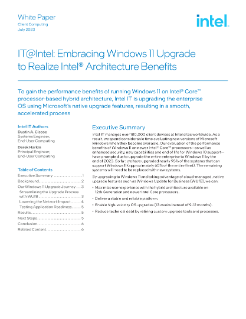Intel IT's Enterprise-Wide Windows 11 Upgrade
Learn how Intel IT accelerated Windows 11 upgrade across the enterprise!
Historically, a major OS upgrade, such as Windows 8.1 to Windows 10, took us 9 to 12 months to complete. Our prior upgrades were performed on-premises using time-consuming task sequences and a custom upgrade user interface that took weeks for our engineers to design and test.
In contrast, using cloud-based
Windows Update for Business (WUfB) enabled us to retire these task sequences and the custom user interface—reducing engineering time from four weeks to just a few days. We completed most of the Windows 11 in-place upgrades in only 13 weeks, once application readiness testing and the pilot project was complete.
Upgrading to Windows 11 provides users with excellent performance while conserving battery life when possible. While Windows 10 has foundational support for Intel® Thread Director, Windows 11 is fully optimized for this performance-enhancing and energy-saving technology. As a result, employees using 12th and 13th Generation Intel® Core™ processor-based devices can obtain the best user experience with Windows 11.
Other considerations also influenced our decision to upgrade to Windows 11:
• Windows 10 will reach end-of-life (EOL) in Q4 2025.
• Windows 11 includes security enhancements, such as requiring Trusted Platform Module (TPM) 2.0.
• Windows 11 also offers new features that can lead to high productivity and increase user satisfaction (see the sidebar, “Windows 11 Enterprise Benefits”).
• WUfB can provide users with a familiar upgrade experience, as well as remove the overhead of managing custom upgrade task sequences and OS images.
Many aspects of our Windows 11 upgrade were similar to previous upgrades. For example, we performed application readiness testing (discussed later in this paper) as usual. We also used deployment rings to mitigate the risk of significant productivity impacts. However, the upgrade to Windows 11 differed from our previous upgrade experiences in two important ways:
• We determined that WUfB is mature enough for enterprise use. We worked closely with Intel’s Information Security group to help ensure low risk and high security.
• A recently deployed PC client telemetry solution called Aternity helped us monitor the environment. This application provides crucial, real-time information about client health, performance and stability across all the client devices equipped with Aternity.
Our strategic plan is as follows:
• Deploy. All new PCs are being deployed with Windows 11 installed.
• Upgrade. As of the writing of this paper, we have upgraded nearly 95% of the devices that can support Windows 11 (about 60% of the entire fleet—those running 10th and 11th Gen Intel Core processors).
• Replace. We plan to replace 70,000 older devices (7th and 8th Gen Intel Core processor-based PCs) with new devices running Windows 11 by the end of 2025. At the writing of this paper, we had already replaced 20,000 devices.
We hope that sharing our Windows 11 upgrade journey inspires other organizations to explore how they might also embrace Windows 11 with minimal disruption to the enterprise.
